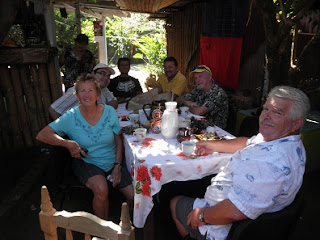On Monday morning, Arturo and Javier picked us up at 8:15 am
along with Annette and Ed of SV Sand Piper. We drove to a town called Tuxtla
Chico or Little Rabbit, close to the border with Guatemala. We drove through
the narrow streets where the one way signs were ignored and three wheeled
pedicabs carried people and goods. Our stop was the home of Rafael and Josefina
and La Parra Chocolha Maya. Josefina is fourth generation of women making
chocolate the traditional, Mayan way. In 2010, Josefina and Rafael were
selected to represent the state of Chiapis as a chocolate exposition in Italy
where they won first prize.
First we have breakfast. Josefina serves hot
chocolate. The first cup is the traditional chocolate, made by boiling water
and stirring in the chocolate, a strong flavor with no sugar added. The second
cup has sugar and cinnamon but no milk, but not too sweet. We have tamales and
bread which you dip into your hot chocolate. The taste is wonderful but Rich
and I found it very filling and we were asked if we were okay and why didn’t we
want some more.
Annette, Arturo, Javier, Rafael, Rich and Ed at breakfast
Next we watched Josefina make the chocolate. Chocolate is
made from the seeds of the cacao tree. The seed pod or corn as it is referred
to and resembles in shape, is removed from the tree. Inside the pod are the
seeds with a gelatinous substance which may be eaten. The seeds are fermented
or separated from the gelatinous stuff and then spread out in the sun to dry similar
to the coffee processes. When the seeds are dried sufficiently they are roasted
over an open fire. You can hear the seeds pop as they heat up, like popcorn and
the chocolate smell fills the air. On a flat surface, Josefina crushes the
roasted seeds to remove the husk. It takes a lot of arm strength and wrist
action. Tossing the crushed material, the husks are blown away and separated
from the chocolate ‘nuts’. This chocolate is put on a sloping stone and crushed
into a fine powder. She mixes in some sugar and previously ground cocoa powder.
This she packs into a mold. Two to four chocolate ‘bars’ would be added to 1-2
liters of boiling water to make the same as our first cup of hot chocolate. Of
course be bought some chocolate to bring back to the boat.
Seed pods on cacao tree
Rafael holds an open seed pod
Josefina roasting over an open fire
Crushing the seeds to break the husks
Tossing the broken seeds so that the husks are removed by the breeze
Grinding the chocolate into powder on a stone slab
Molding the chocolate
The chocolate bar and the packaged items, Chocolate with cinnamon and plain dark chocolate
We enjoyed our visit with Josefina and Rafael. Arturo took
us to the main square of Tuxtla Chico and we walked around and took a few
pictures. Inside the main church was a statue of a saint. The knife in his head
seems a little unusual. We speculated that he is the patron saint of migraine
sufferers but we don’t know for sure.
Tricycle cabs waiting for customers by the market
The church
Patron saint of migrain sufferers ?
It was
fitting that as chocolate is a Mayan tradition that we visited one of the
first, pre-Classic, Mayan sites, Izapa. This site is in a prime location
surrounded by trees bearing tangerines, avocados, cacao, mangos plus more and
was settled as early as 1500 B.C.E. It is where the original Mayan calendar was
discovered. Located on the Izapa river, near the base of the Tacana volcano, the
fourth largest mountain in Mexico there is a ball court and a ceremonial alter,
where the captain of the winning team, freely gave himself for sacrifice, as it
was considered an honor. The chocolate seeds were also used as currency and as
a drink only for the rulers. Near the pyramids is a square platform with smooth
rocks at each corner. Sentries would stand on these rocks and make sure that
the chocolate was made according to the rules and that none of the seeds went
unaccounted for. One of the pyramids was used for celestial and lunar
observations.
Izapa Mayan site oriented to the volcano, Tacano, in the distance
Early ball court to the left, Chocolate square to the right
The tour was fun and we have a greater appreciation for
chocolate besides the fact that it tastes so good. So if you are a fan of dark
chocolate and you are in Chiapis, take this tour with Arturo and Macaw Tours





































